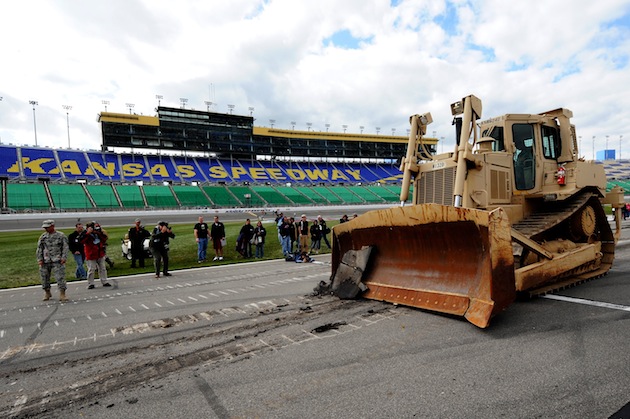
We've found out over the last few weeks that NASCAR drivers prefer a worn out, slick surface over a freshly paved track. And we know from experience that tracks, especially intermediate ones, typically have a break-in period of a few years as a second groove works its way in as the track surface weathers and ages.
Many drivers felt that the surface at Kansas Speedway was just reaching its sweet spot. The track's 15 degrees of banking in the corners was heavily featuring three different lines of racing, as the 11 years of Midwest winters and summers had worn the track.
However, the weather conditions took their toll underneath that top layer of asphalt.
"Visually, looking at the surface, the asphalt — if you go take a look at it — doesn't look bad," ISC director of engineering Martin Flugger said. "But the problem isn't so much on the top layer, it's the bond between the layers and then the cracking itself. So there's the real possibility that a section of the track could actually — that a layer of the top surface could pull off."
Yes, that means you, Daytona pothole.
"Everybody thought Daytona looked great until that hole opened up in the middle of Turn 1 and 2 because of problems that weren't necessarily right at the top but were basically down into the asphalt," Flugger explained.
Repaving Sprint Cup tracks has become very common over the last 10 years — there are more ovals on the 2012 schedule with pavement in the single digits than not — and as track technology has advanced, progressive banking has emerged as the preferred option. (Well, OK, maybe not in the case of Bristol, which announced on Wednesday that the top groove in the corners of the track would be ground down. But according to Dale Earnhardt Jr., progressive banking on concrete is a different proposition than it is on asphalt.)
Progressive banking is when the degree of banking in the corners increases as you go from the white line to the wall. The idea is to create multiple lanes of racing immediately.
"What we're trying to do on is, on the front end, build in multiple lines coming through the corner," Flugger said. "In order to do that, we have to bring up the banking a little bit and give a little bit of banking to each of the lanes incrementally, so you're a little flatter at the bottom and slowly work your way up to the top with a little more banking."
The birthplace of progressive banking in the Sprint Cup Series can be traced back to Homestead-Miami Speedway.
"It really kind of came about back when we were looking at Homestead, which was some nine years ago," Flugger said. "And they knew the repave was coming, they knew they were going to change the track and they were trying to look at ways they could, in their opinion at the time, make it better."
At Homestead, the track was reconfigured from it's flat, more-rectangular layout to an oval with 18-20 degrees of banking in the corners in 2003.
"I think a lot of tracks I can look at and think about ones they reconfigured and I don't think they made better, but if you want to use Homestead for an example, that's just about a perfect race track," Matt Kenseth said on Friday. "They did the variable banking and it used to be so flat. It's got the most banking on the top, but not very much more, and it's pretty darn competitive."
The shape and size of Kansas is staying the same, while the banking is moving to 17-20 degrees in the corners, the steepest possible within the track's current configuration.
"We've got an existing system around the outside of the track right now. To get from 15 degrees, as you start to ramp up to 20 degrees, you have to get that real estate from somewhere, and to hold the inside of the track where it is right now and try to get 24 degrees (of banking), well it starts to incrementally climb up that wall to the point where if I'm at 24 degrees, I'm probably over the top of the wall," Flugger said, angling a business card on the table in front of him as a demonstration.
"You kind of work within the box that you have to see how much you can get out of it without climbing the wall too much [or] without taking away too much of the remaining track."
At Kansas, the white line will be further to the inside of where it was, meaning that during the repave process the track will be taking a scoop out of the bottom portions of the banking while raising the hill towards the wall. The track is banked in sections, rather than in a linear fashion, so the bottom 13 feet of the track will be at 17 degrees while the top 19 feet will be at 20 degrees.
After it's decided what the maximum banking can be within the limitations of the facility, Flugger said that computer simulations are run over and over to find the ideal gradient and banking increase to attempt to ensure that multiple lines of racing will be equally competitive as soon as the track opens. Once the simulation finds two lines to be as equal as possible, other lines are explored. According to Flugger, the new Kansas setup will have three lines.
"As soon as you start to basically get those numbers closer and closer, once you get within that window, then all of the sudden a second line is now as fast as the preferred line, and then you start to build on that. And then that's where you start to work in a third line, and if you can, a fourth line," Flugger said.
How many lines will there immediately be once cars take to the track? We'll find out in October.